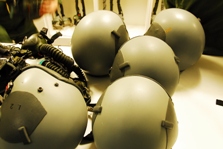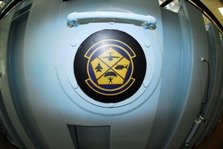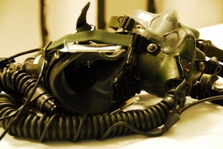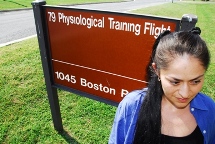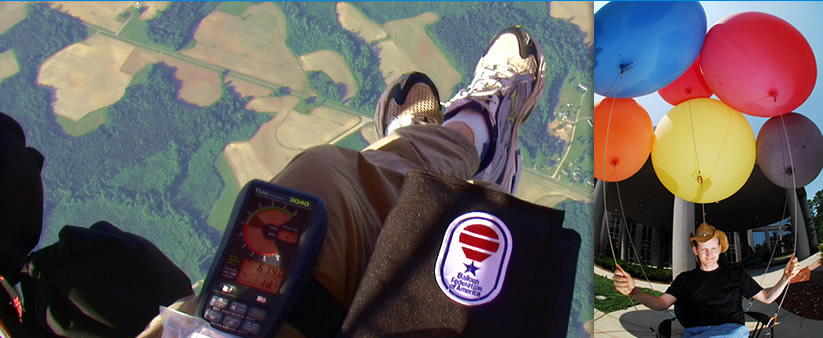High Altitude Chamber Flight, August 7th 2008
Inside the High-Altitude Chamber, Andrews Air Force Base
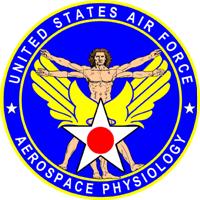 One of my long-term goals as a pilot is to fly a balloon to an altitude higher than Mt. Everest. I don't mean over Mt. Everest itself-- I mean higher than it: 29,029 feet. One of the many components of such a flight will be addressing the questions of aerospace physiology such as trapped gasses, altitude induced decompression sickness, and hypoxia.
One of my long-term goals as a pilot is to fly a balloon to an altitude higher than Mt. Everest. I don't mean over Mt. Everest itself-- I mean higher than it: 29,029 feet. One of the many components of such a flight will be addressing the questions of aerospace physiology such as trapped gasses, altitude induced decompression sickness, and hypoxia.
Under an agreement with the United States Air Force, the FAA has a class that addresses these topics. Have you seen movies where they take astronaut types and put them in an altitude chamber then try and get them to do simple tasks? While in the chamber the candidates are asked to play patty-cake, or add 33 + 28, or correctly identify the Queen of Spades—and the candidates fail spectacularly.
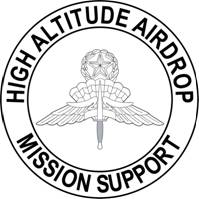 That is what I did in that class! Failed spectacularly!
That is what I did in that class! Failed spectacularly!
Going into something like this high-altitude chamber isn’t the type of thing we normally get to do. I mean, you see it in movies or on the Discovery channel, but it isn’t common to be able to go experience that astronaut stuff yourself.
Well, if you’re a pilot (or a student pilot!) you can.
Through the FAA, my girlfriend and I registered for a class at Andrews Air Force Base, just outside of Washington D.C. You need a Class III medical certificate, which is easily obtained through a quick appointment with a local aviation doctor. (I called a local flight school and they e-mailed me a list of doctors in my area. The exam and medical certificate cost $85.00.)
The FAA’s Civil Aerospace Medical Institute sent me a registration letter. With the medical cert and that letter in hand, we made the 300 mile drive up to the air force base. As you might imagine, it’s a reasonably secure facility; we were supposed to meet an escort who would take us to the building with the hypobaric altitude chamber. There was a big sign indicating that 100% positive ID checks were in effect, and soldiers guarded the gate. Um, but the security was somewhat illusory: we went to the gate, told them we were here for the FAA class, and were waived through. No ID check after all.
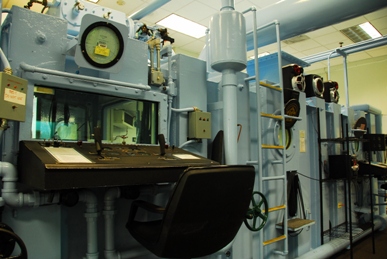 We arrived at the facility and were greeted by two very cool chambers: the altitude chamber, and a medical treatment chamber. They were both pressure chambers, but one was designed for the altitude flight, and the other was designed to treat pilots that were experiencing decompression illness. Thankfully, on the day of our flight nobody needed the treatment chamber
We arrived at the facility and were greeted by two very cool chambers: the altitude chamber, and a medical treatment chamber. They were both pressure chambers, but one was designed for the altitude flight, and the other was designed to treat pilots that were experiencing decompression illness. Thankfully, on the day of our flight nobody needed the treatment chamber
The day started with a classroom session discussing the three main topics in high-altitude flights: hypoxia, trapped gasses, and high-altitude decompression sickness.
Hypoxia in high-altitude flying is caused by the inability of the respiratory system to absorb enough oxygen to support the 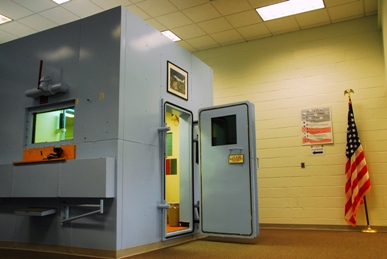 body. When breathing the less dense air at altitude you're breathing the same volume of air, but the air is much thinner- literally. So you're getting less oxygen-- and the brain and some organs don't work so well without oxygen!
body. When breathing the less dense air at altitude you're breathing the same volume of air, but the air is much thinner- literally. So you're getting less oxygen-- and the brain and some organs don't work so well without oxygen!
When ascending to higher altitudes (and lower pressures) gas can be trapped in the middle ear, the sinuses, gastrointestinal tract, the lungs-- and even in the teeth. As pressure decreases at altitude the gas trapped in your body expands and it can become quite uncomfortable! For certain areas you can...um...'vent' the gas, or perform a maneuver to equalize the pressure. But, trapped gas in certain areas can only be relieved by descending to lower altitudes.
The third main physiological area for this type flight is High Altitude Decompression Sickness. HADCS involves the formation of nitrogen gas bubbles in your blood. When these bubbles form, they can lodge in your joints, your lungs, your skin-- or even in the spinal cord and brain. Serious pain or neurological effects can ensue. All these effects of decompression sickness come from nitrogen bubbles forming in the blood-- so it is critical to purge the nitrogen from your system (by pre-breathing 100% oxygen) prior to flight.
After the academic introduction to these topics we got fitted with aviators breathing masks and helmets, and it was into the chamber!
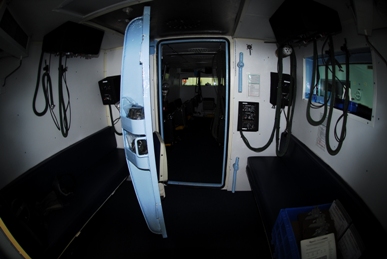 The chamber has two sections-- an inner and outer chamber. We went all the way in and the airmen got us hooked up. The masks connected to oxygen sources in the innermost chamber, and we did a quick test flight. Doors closed, two airmen in the chamber with us, masks securely against our faces with an air-tight seal. Then, the chamber controllers zoomed us up to 5,000 feet at 2,500 feet per minute. If you are going to have problems develop with trapped gas (in the sinuses, ears, gastrointestinal system) they will likely develop in the first 5,000 feet.
The chamber has two sections-- an inner and outer chamber. We went all the way in and the airmen got us hooked up. The masks connected to oxygen sources in the innermost chamber, and we did a quick test flight. Doors closed, two airmen in the chamber with us, masks securely against our faces with an air-tight seal. Then, the chamber controllers zoomed us up to 5,000 feet at 2,500 feet per minute. If you are going to have problems develop with trapped gas (in the sinuses, ears, gastrointestinal system) they will likely develop in the first 5,000 feet.
Our whole team survived the zoom up to 5,000, and we were now familiarized with the equipment. Then, the real flight was to begin.
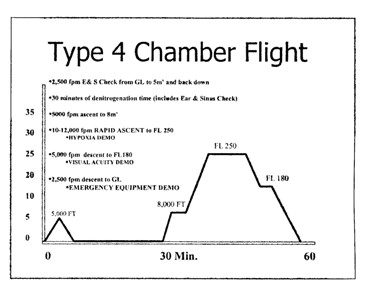 To the right you can see the flight profile we were to undertake. Do you see that spike up to 5,000 feet, then the quiet zone back down at sea level?
Before you can go to great altitudes you need to purge the nitrogen from your blood so that it doesn't form into gas bubbles and lodge in inconvenient places-- like your brain. Verrrrry important to get rid of the nitrogen! You do this by going to 100% pure oxygen and 'pre-breathing' before the ascent. Pre-breathing for 30 minutes eliminates most of the nitrogen from your blood; you can get rid of a little more nitrogen if you pre-breath longer, but you get decreasing returns: lots more time to get the last little bit of nitrogen out. So, that is what we were doing during that quiet time back down at sea level. While breathing off the nitrogen we watched a video in the chamber! They actually started with some historic high altitude ballooning info~~ cool.
To the right you can see the flight profile we were to undertake. Do you see that spike up to 5,000 feet, then the quiet zone back down at sea level?
Before you can go to great altitudes you need to purge the nitrogen from your blood so that it doesn't form into gas bubbles and lodge in inconvenient places-- like your brain. Verrrrry important to get rid of the nitrogen! You do this by going to 100% pure oxygen and 'pre-breathing' before the ascent. Pre-breathing for 30 minutes eliminates most of the nitrogen from your blood; you can get rid of a little more nitrogen if you pre-breath longer, but you get decreasing returns: lots more time to get the last little bit of nitrogen out. So, that is what we were doing during that quiet time back down at sea level. While breathing off the nitrogen we watched a video in the chamber! They actually started with some historic high altitude ballooning info~~ cool.
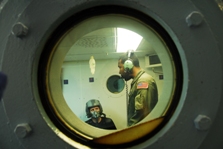 Note: you can't come off the oxygen even for a minute, including after you launch and climb to altitude. You must stay on 100% oxygen during ascent, while enroute, and during descent. Prebreathing is an effective method to protect against altitude decompression sickness, but it is not logistically simple or inexpensive for private or even commercial aviators. At the present time it is only being used by military flight crews and astronauts for their protection during high altitude and space operations-- plus a tiny slice of balloonists who are really going up into that thin air!
Note: you can't come off the oxygen even for a minute, including after you launch and climb to altitude. You must stay on 100% oxygen during ascent, while enroute, and during descent. Prebreathing is an effective method to protect against altitude decompression sickness, but it is not logistically simple or inexpensive for private or even commercial aviators. At the present time it is only being used by military flight crews and astronauts for their protection during high altitude and space operations-- plus a tiny slice of balloonists who are really going up into that thin air!
Now: it's time. We've all done our trapped-gas test when we went up to 5,000. We've all been in the chamber pre-breathing for 30-minutes, including two USAF Airmen that were in the chamber with us. We're ready, and they start to take us up. About 9.9% of chamber participants experience 'undesirable reactions.' That could be a range of things from minor discomfort to screaming pain. Remember how we did the test to 5,000 feet, zooming up at 2,500 feet per minute? Well, now we're doubling that, climbing at 5,000 feet per minute. At 8,000 feet we level off for a minute-- then we double the rate of climb again, going up at 10,000 to 12,00 feet per minute for 'rapid decompression.'
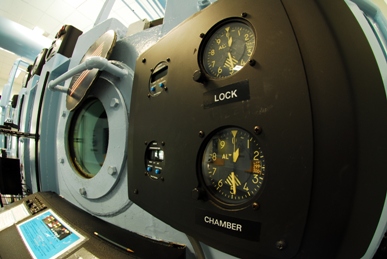 And something happens. They stop the climb. None of the students are raising the alarm-- we all have microphones and headsets in our masks and helmets and we can hear each other on the comm. But none of us are raising the alarm. However, my girlfriend was outside the chamber, using a set of headphones that monitored both the participants and the Airmen. One of the very experienced airmen hit a problem and they had to stop the climb. He had trapped gas expand in his gastrointestinal system and couldn't ...vent. It can be very painful-- but his buddies on the headsets were merciless! They teased him like mad! "What's wrong Airman, too much fiber this morning?"
And something happens. They stop the climb. None of the students are raising the alarm-- we all have microphones and headsets in our masks and helmets and we can hear each other on the comm. But none of us are raising the alarm. However, my girlfriend was outside the chamber, using a set of headphones that monitored both the participants and the Airmen. One of the very experienced airmen hit a problem and they had to stop the climb. He had trapped gas expand in his gastrointestinal system and couldn't ...vent. It can be very painful-- but his buddies on the headsets were merciless! They teased him like mad! "What's wrong Airman, too much fiber this morning?"
The flight had to be stopped-- but the guy didn't get better. They took us back down a little. It didn't help. Remember how there are two chambers, an inner chamber and an airlock? Well, this is why. The airman had to leave the flight. He went out of the first door, bolted it up, and once inside the airlock they started to take him back down to sea level. We maintained our altitude, and were left with one airman. She continued the flight with us.
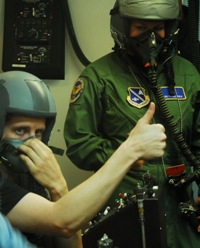 We go up. And up. They watch us closely. Take a look at the photo here; the eyes tell a lot of the story. The airman is watching very closely for adverse signs. I'm fine, and giving the 'thumbs up' to the flight controller. No problems-- but my eyes do seem to tell a slightly different story!
We go up. And up. They watch us closely. Take a look at the photo here; the eyes tell a lot of the story. The airman is watching very closely for adverse signs. I'm fine, and giving the 'thumbs up' to the flight controller. No problems-- but my eyes do seem to tell a slightly different story!
We're at 25,000 feet. Without the masks, the air would be very thin.
We take off the masks.
While hypoxic, people have very different reactions. The officers told us a story of a U.S. Marine that they had in their chamber-- a big guy. His reaction to the lack of oxygen was to become belligerent. He wouldn't go to oxygen! He stood up and shouted "I ain't going to oxygen!!" Woooah K big guy. No problem. No problem. They knew he'd black out soon enough, and they'd get the mask back on him at that time. Which is what they did!
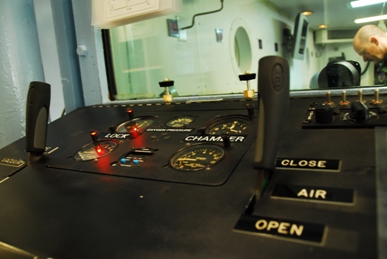 Other people get euphoric. VERY dangerous. If you get happy without the mask, then you really don't want to put the mask back on! It's much better if you get sick or dizzy without the oxygen-- because you're more likely to self-rescue.
Other people get euphoric. VERY dangerous. If you get happy without the mask, then you really don't want to put the mask back on! It's much better if you get sick or dizzy without the oxygen-- because you're more likely to self-rescue.
We're off the masks, and we're trying to do some puzzles that they've given us. They're asking us questions over the headsets. I'm trying to do my math questions. (I was supposed to add 4732 + 622. I spent a couple minutes trying to multiply 4732 x 622. To my credit, that is much harder. Not to my credit, I messed it up.)
I moved on to the maze. My whole consciousness was....kind of like throbbing. Well, throbbing goes up and down in cycles. I wasn't going 'down'-- just the 'up' part. And I was...dizzy. They came over the headset. "Chair 1! Identify your symptoms!" "Uhha ..dizzy...uhha...tingling." I circled the items on my list. When I finished broadcasting the chamber airman helpfully added "and you have slurred speech." Really? I didn't know that. Thank you.
Now I'm trying to count backwards, per instructions on the sheet. Backwards from 100, subtracting 4 each time. I start: 96...92...88...82 [wrong!]...78...74...70...68 [wrong!]...64...60...56...54 [wrong!]...50. I was pretty loopy. Let's just say it's a good thing I wasn't trying to dial an aircraft radio, or figure out a complicated oxygen setup.
The voice came over the comm: "Chair 1! What would you do if you felt like this and you were flying solo?" "Chhair 1, I would...[thinking] if I was flying solo ...[thinking] go to my oxygen!]" But I'm also thinking 'I'm not on the verge of blacking out yet!' Everyone else in the chamber has gone back to oxygen except 1 guy. (He thought he was fine. He was so wrong!)
Ok. That's it. Time to rescue. Get some oxygen! Mask on. Snaps connected. Push the valve for double blast of oxygen--- and normalcy returns. The one guy remaining should take a very important lesson: he can't tell when he's hypoxic! He thought he was doing ok. He was gone.
Eventually they get him to rescue. And we're there, 25,000 feet. Everything comes back very quickly. Normalcy returns; you become clear again.
The flight continued with some additional really great sessions. We dropped to a lower altitude and went without the masks again to demonstrate the vision impacts of flying in the lower oxygen altitudes. Again: put the mask back on and it all comes back so quickly. There were additional classroom sessions afterwards and a demonstration on night-vision and flying near twilight-- really relevant for balloon pilots! We often fly near the twilight hours.
All told, it was a great experience. It was interesting, fun, and even more valuable than I had hoped. I was interested in the high-altitude preparation but I got much more than that. If you have the opportunity, I'd really recommend any pilot participate.
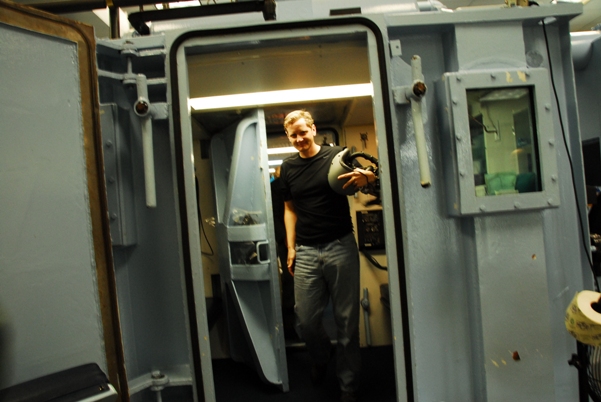
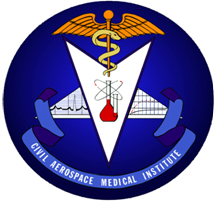 To Participate: The class is offered at 15 Army and Air Force bases across the country as well as at the FAA facility in Oklahoma City. You can simply contact the Civil Aerospace Medical Institute at (405) 954-4837. At the time of this writing the Airman Education coordinator was Don 'DJ' DeMuth; he assisted with my registration. The course cost is $50.00; chamber participants must have a Class III Medical Certificate.
To Participate: The class is offered at 15 Army and Air Force bases across the country as well as at the FAA facility in Oklahoma City. You can simply contact the Civil Aerospace Medical Institute at (405) 954-4837. At the time of this writing the Airman Education coordinator was Don 'DJ' DeMuth; he assisted with my registration. The course cost is $50.00; chamber participants must have a Class III Medical Certificate.
Online details: Further information can be found online. Visit the Airman Education page at the Civil Aerospace Medical Institute.
